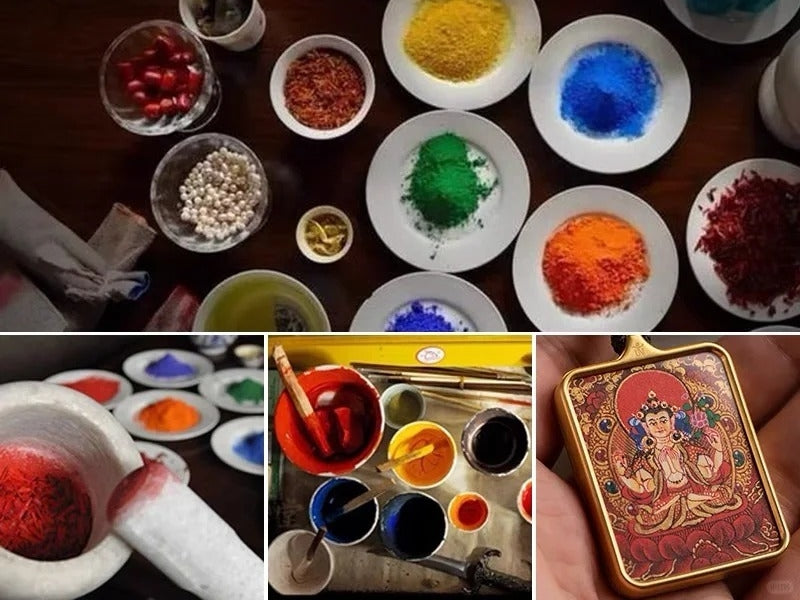Parenting asks a lot from our attention, patience, and heart. For many families inspired by Tibetan Buddhist culture, a guardian Buddha can become a practical anchor—less as a shortcut to perfect parenting and more as a steady reminder of care, ethics, and protection. This article explains family-oriented guardian Buddhas, gentle daily practices parents can use, and culturally sensitive advice about children wearing sacred jewelry.
Which guardian Buddhas are commonly chosen by families — and why
Different guardian figures offer different kinds of spiritual support. Here are a few commonly chosen by households and what they represent:
-
Four-Armed Avalokiteshvara — the bodhisattva of compassion. Families often turn to Chenrezig for patience, kindness, and emotional presence.
-
Green Tara — associated with swift aid and protective compassion. Parents sometimes invoke Green Tara for safety during travel or to calm sudden fears.
-
Medicine Buddha (Bhaisajyaguru) — focused on healing and well-being, appropriate when seeking comfort during illness or for general health protection.
-
Amitabha Buddha — embodies boundless light and peaceful intention; families may look to Amitabha for a calm household atmosphere and positive bedtime practice.
-
Yellow Jambhala — linked with right livelihood and ethical prosperity; often included when practical stability is a family priority.
-
Mahakala (cautious use) — powerful protector in Tibetan practice, but his fierce iconography can be intense for young children; use with guidance and contextual understanding.
Choosing a family protection Buddha is less about rules and more about resonance: which image or quality calms your home, guides your behavior, and supports your caregiving aims?
Simple, child-friendly daily practices
You don’t need long rituals or ordination to bring blessing into family life. Small, consistent habits are both accessible and meaningful.
-
Morning intention (1–2 minutes). While getting everyone up, set a simple intention aloud: “May we be kind today.” If you keep a small image or pendant near the breakfast table, touch it briefly as a reminder.
-
Short mantra burst (30–60 seconds). Choose a very short phrase or single mantra syllable appropriate to your tradition—five calm breaths while thinking of compassion (Avalokiteshvara) or healing (Medicine Buddha) is enough. For young kids, keep it playful: a single chime, a shared breath, or a line like, “May everyone be safe.”
-
Bedtime dedication (1–3 minutes). Light a small lamp or candle (safely) or place a lamp image on the bedside gawu. Offer a short dedication: “May we sleep safely and wake ready to help others.” Singing a simple lullaby that echoes compassion works well for toddlers.
-
Micro-offerings. Keep a tiny water bowl on a family altar or gawu; changing the water daily becomes a tactile way to teach care and respect. Children can be invited to help—this is both educational and devotional.
These practices are about training attention and modeling values for children. The spiritual object (pendant, Thangka, bedside gawu) functions as a cue for the parent’s own steadiness rather than a magical protector.
Bedside gawu and home altar tips
A gawu (portable shrine box) or a small home altar can help center family routines. Keep it simple and child-safe:
-
Place the gawu on a stable, elevated surface out of grab range for infants and toddlers.
-
Include one or two meaningful items: a small image of your chosen guardian Buddha, a water bowl, and a clean cloth.
-
Avoid fragile or choking-hazard items within reach of children; prioritize safety over aesthetic completeness.
-
Use the gawu as a place for short family dedications before meals or bedtime rather than as an object of curiosity.
Children and sacred jewelry: safety and sensitivity
Many parents wonder whether children can wear protective amulets or Buddha pendants. A few practical and culturally respectful guidelines:
-
Age and safety first. For infants and very young children, avoid necklaces and small loose beads due to choking and strangulation risks. Small, sewn-in pouches in clothing or embroidered symbols are safer alternatives.
-
Teach respect. If a child wears a pendant, explain briefly what it symbolizes and why it’s treated with care. Simple instructions like “this is special—keep it clean” are age-appropriate.
-
Avoid toyification. Don’t present sacred objects as toys. Children should learn that sacred images are treated differently from playthings.
-
Consent matters. Let older children decide if they want to wear a symbol. Forcing a sacred item on a child can disconnect them from its meaning.
-
Secure mounting. If worn, use breakaway cords or enclosed lockets that reduce risk; keep regular checks for wear and tear.
Sourcing and consecration — respectful practices
When you bring a guardian image into the home, check how it was made and where it came from. Ethical sourcing supports traditional artisans and preserves cultural integrity.
-
Buy from makers who identify as Tibetan or Himalayan artisans, or from ethical sellers who work with those communities.
-
If a piece is consecrated, ask about the context—who blessed it and in what tradition? That information helps you integrate the piece respectfully into family practice.
-
If no consecration is available, a brief family dedication or blessing (spoken intention, water offering, or short chant) can personalize the object in a meaningful, low-barrier way.
Final note: practice over perfection
A guardian Buddha for the family isn’t a quick fix; it’s a gentle support system for everyday ethics, attention, and care. Small, steady routines—an intention in the morning, a dedication at night, mindful handling of sacred objects—create a family culture that privileges compassion and safety. Over time, those tiny habits shape how children see the world: as a place to care for others and be cared for in return.










